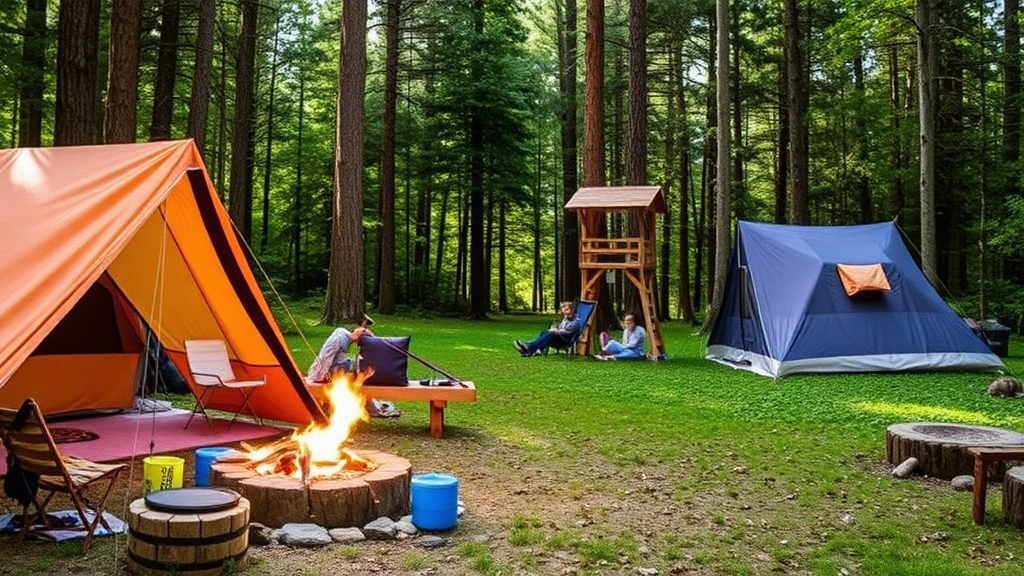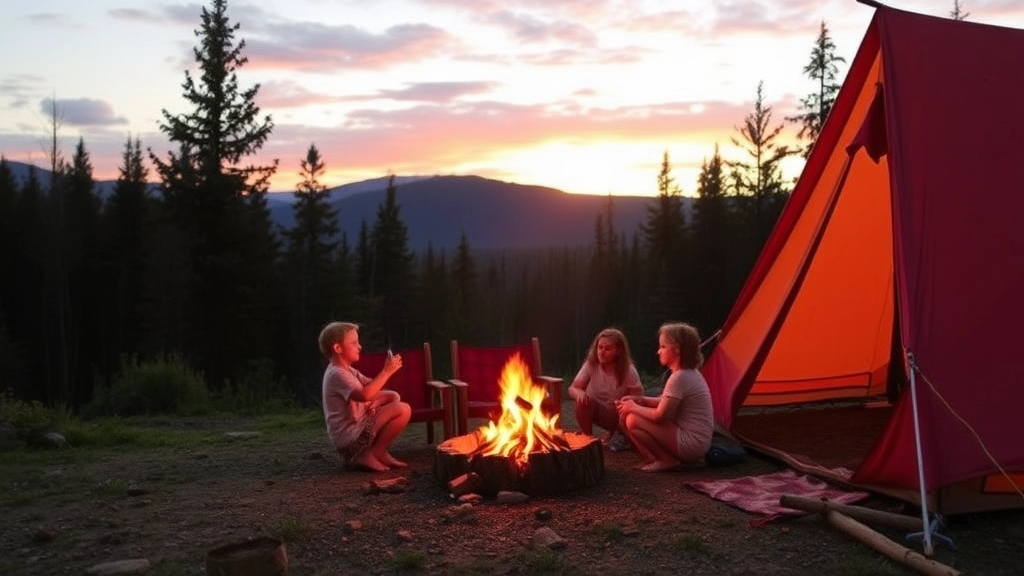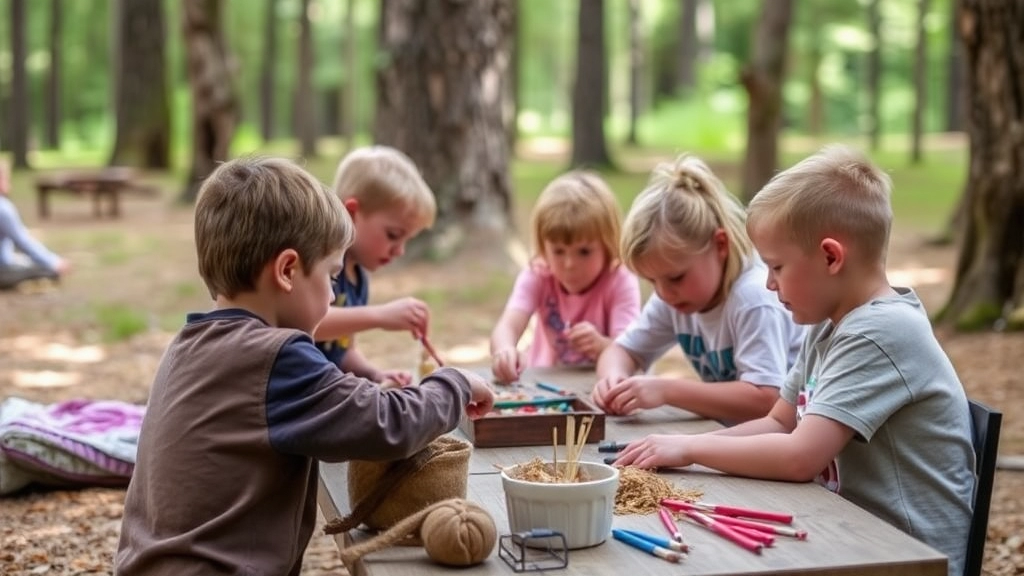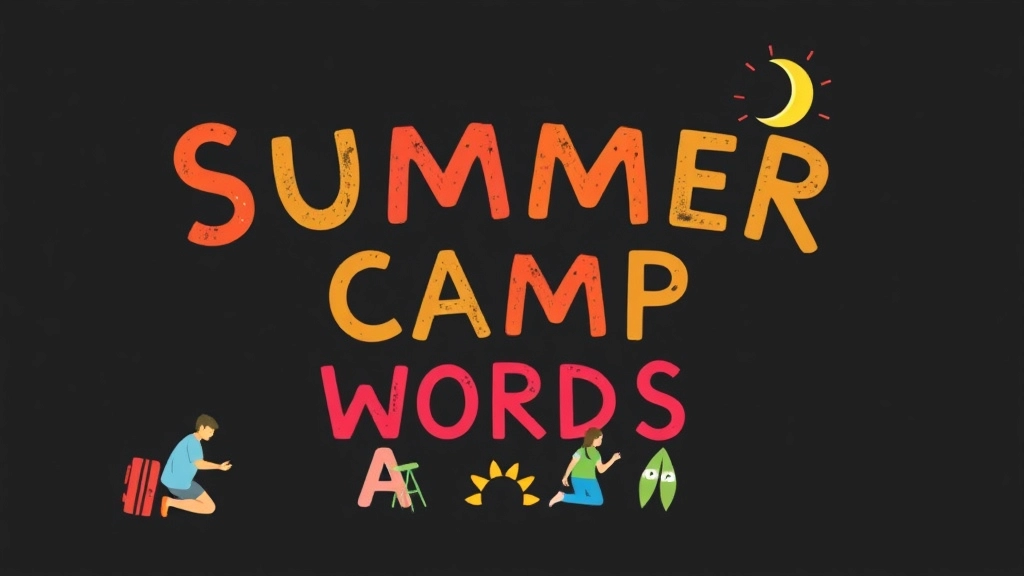Welcome to the ultimate guide on “Summer Camp Words”!
Whether you’re a first-time camper, a seasoned counsellor, or a curious parent, understanding the vocabulary of summer camp can significantly enhance your experience. From essential terms and popular activities to campfire culture and team-building lingo, this article covers it all. Let’s dive into the words that define the magic of summer camp.
Explore the Vocabulary
In this comprehensive guide, we’ll explore everything from basic camp vocabulary to the unique slang and jargon that make camp life so special. Discover the terminology behind popular activities like canoeing, archery, and arts and crafts. Learn about the words that capture the essence of camp traditions, outdoor adventures, and water activities. We’ll also delve into team-building and leadership terms, and the enchanting language of campfire culture. Ready to become a summer camp vocabulary pro? Let’s get started!
Essential Summer Camp Vocabulary
Alright, let’s dive into the essential summer camp vocabulary. If you’re gearing up for your first camp experience or just want to brush up on your lingo, you’re in the right place. Whether you’re a camper, a parent, or a counsellor, knowing the right terms can make all the difference. Let’s break it down.
Why Knowing Camp Vocabulary Matters
Ever felt out of place because you didn’t know the jargon? Yeah, it’s not fun. Imagine being at camp and not knowing what a “counsellor-in-training” is or what “lights out” means. It’s like being in a foreign country without a translator. Knowing the right words helps you fit in, understand instructions, and make the most out of your camp experience.
The Basics: Must-Know Terms
Campers and Staff
- Camper: That’s you or your kid. The person attending the camp.
- Counsellor: The adult or older teen responsible for a group of campers.
- Counsellor-in-Training (CIT): A camper who is learning to become a counsellor.
- Director: The head honcho, the person in charge of the entire camp.
Daily Schedule
- Reveille: The wake-up call, usually a bugle or bell.
- Taps: The signal for lights out, marking the end of the day.
- Mess Hall: The dining area where meals are served.
- Cabin: Your home away from home, where you sleep and store your stuff.
Activities and Events
- Campfire: A gathering around a fire, often with songs and stories.
- Flagpole: The area where the flag is raised and lowered daily.
- Free Time: Unstructured time where campers can choose their own activities.
- Hike: A long walk, usually in nature, and a staple of camp life.
Real-Life Examples
Picture this: It’s your first day at camp. You hear the reveille at dawn, and you head to the mess hall for breakfast. Your counsellor tells you about today’s hike and the evening campfire. You end the day with taps, signalling it’s time to hit the sack. Knowing these terms, you’re not just surviving camp, you’re thriving.
Quick Reference Table
| Term | Meaning |
|---|---|
| Camper | Person attending the camp |
| Counsellor | Person responsible for a group of campers |
| CIT | Counsellor-in-Training |
| Director | Person in charge of the camp |
| Reveille | Wake-up call |
| Taps | Lights out signal |
| Mess Hall | Dining area |
| Cabin | Sleeping and storage area |
| Campfire | Evening gathering around a fire |
| Flagpole | Area for flag ceremonies |
| Free Time | Unstructured activity time |
| Hike | Long walk in nature |
Popular Camp Activities and Their Terms

Ever wondered what makes summer camp so exciting?
It’s the activities, mate!
From canoeing to archery, there’s something for everyone.
But let’s dive into the lingo, shall we?
Canoeing and Kayaking
First up, canoeing and kayaking.
These water sports are a big hit.
- Paddle: The tool you use to move your canoe or kayak.
- Portage: Carrying your boat overland between two bodies of water.
- Capsize: When your boat flips over. Not fun, but it happens.
Archery
Next, we’ve got archery.
Ever tried hitting a bullseye?
- Bow: The tool you use to shoot arrows.
- Arrow: The projectile you shoot.
- Quiver: The container for your arrows.
- Target: What you’re aiming at.
Hiking
Now, let’s talk hiking.
A simple walk in the woods? Think again.
- Trail: The path you follow.
- Blaze: Markings on trees to guide you.
- Summit: The peak of a hill or mountain.
- Backpack: Your trusty gear carrier.
Campfires
Ah, the good ol’ campfire.
Nothing beats sitting around a fire, right?
- Kindling: Small sticks to get the fire going.
- Embers: The glowing remains of the fire.
- S’mores: The ultimate campfire treat. Graham crackers, chocolate, marshmallows.
Team Sports
Finally, let’s not forget team sports.
From football to capture the flag, teamwork makes the dream work.
- Goal: The target area you aim to score in.
- Offside: A rule violation in many sports.
- Huddle: A quick team meeting on the field.
- MVP: Most Valuable Player. The star of the game.
So, there you have it.
A quick rundown of popular camp activities and their terms.
Got any favourites?
Or maybe you’re itching to try something new?
Either way, knowing the lingo makes it all the more fun.
Understanding Camp Slang and Jargon
Ever found yourself at a summer camp and felt like everyone was speaking a different language? You’re not alone. Understanding camp slang and jargon can be tricky, but it’s essential to truly immerse yourself in the camp experience. Let’s break it down.
Why Does Camp Have Its Own Language?
Picture this: you’re new at camp, trying to make friends, but everyone keeps using words and phrases that sound like a foreign language. It’s frustrating, right? Camp slang and jargon develop because camps are tight-knit communities with unique cultures. These terms help create a sense of belonging and camaraderie.
Common Camp Slang and Jargon
Here’s a quick rundown of some common camp terms you might hear:
- Cabin Fever: When campers get restless from being indoors too long.
- Bug Juice: The brightly coloured, sugary drink served at meals.
- Counsellor: The older teens or adults who supervise and guide campers.
- CIT (Counsellor-in-Training): A camper in training to become a counsellor.
- Mess Hall: The dining area where everyone eats together.
- Lights Out: The time when everyone has to be in their bunks and quiet.
How to Get the Hang of Camp Lingo
Worried about fitting in? Don’t be. Here’s how you can quickly pick up camp slang:
- Listen and Learn: Pay attention to how others use certain words and phrases.
- Ask Questions: If you don’t understand something, just ask. Campers and counsellors are usually happy to explain.
- Practice: Use the new terms in your conversations. The more you use them, the more natural they will feel.
Real-Life Example: My First Day at Camp
I remember my first day at camp vividly. I walked into the mess hall and heard someone shout, “Who wants more bug juice?” I was baffled. Bug juice? Why would anyone drink that? It wasn’t until later that I learned it was just the camp’s nickname for the fruit punch. Moments like these are what make camp special and memorable.
Why Understanding Camp Slang Matters
Getting a grip on camp slang isn’t just about fitting in; it’s about fully participating in camp life. When you understand the lingo, you can:
- Communicate Effectively: You won’t miss out on important information or instructions.
- Build Relationships: Shared language fosters stronger connections with fellow campers and counsellors.
- Enhance Your Experience: Knowing the slang makes activities and traditions more enjoyable.
For more tips on making the most out of your camp experience, check out our Essential Guide for Summer Camp Leaders. And if you’re looking for fun ways to engage with your camp community, don’t miss our Custom Summer Camp Certificates article!
Words that Define Camp Traditions

Ever wondered what makes summer camp so special?
It’s the traditions.
These are the things that keep campers coming back year after year.
But what exactly are these traditions?
Let’s break it down.
Campfire Ceremonies
Campfire: This is the heart of camp traditions. It’s where stories are told, songs are sung, and marshmallows are roasted.
S’mores: Speaking of marshmallows, s’mores are a must-have. Graham crackers, chocolate, and toasted marshmallows—simple but iconic.
Flag Ceremonies
Flag Raising: Every morning, campers gather to raise the flag. It’s a time of unity and respect.
Flag Lowering: At the end of the day, the flag is lowered. It’s a moment of reflection.
Cabin Awards
Cabin Clean-Up: Keeping your cabin tidy isn’t just about cleanliness; it’s a competition. Winning the cleanest cabin award is a big deal.
Spirit Stick: This is awarded to the cabin that shows the most camp spirit. It’s a symbol of pride and camaraderie.
Theme Days
Crazy Hair Day: One day you might have to show up with the wackiest hairdo you can think of. It’s all about fun and creativity.
Twin Day: Find a buddy and dress alike. It’s a simple yet effective way to build bonds.
Talent Shows
Skits: Campers put on short, often humorous performances. It’s a chance to shine and make everyone laugh.
Talent Acts: Whether it’s singing, dancing, or magic tricks, everyone gets a moment in the spotlight.
Camp Songs
Camp Songs: These are unique to each camp. They’re sung at meals, during activities, and especially around the campfire.
Song Leaders: These are the campers or staff who lead the songs. They’re usually the most enthusiastic ones.
Closing Ceremonies
Final Campfire: The last campfire of the session is always special. It’s a time to reflect on the memories made.
Awards Night: This is when campers are recognised for their achievements, whether it’s in sports, arts, or just being a great friend.
So, there you have it.
The words that define camp traditions.
These are the things that make summer camp unforgettable.
Got any camp traditions you love?
Share them with us!
Outdoor Adventure Terms at Camp
Ever find yourself scratching your head over the lingo tossed around during outdoor adventures at summer camp? You’re not alone. Let’s break down some essential outdoor adventure terms so you can jump in with both feet, feeling confident and ready to roll.
Why Understanding Outdoor Adventure Terms Matters
Before we dive in, let’s get real for a second. Have you ever felt left out because you didn’t know what “belay” or “portage” meant? Or maybe you hesitated to join an activity because the terminology seemed like a foreign language? Understanding these terms can make a world of difference, not just for your confidence but also for your safety and enjoyment.
Must-Know Outdoor Adventure Terms
- Belay: This isn’t just a fancy word rock climbers throw around. Belaying is the technique of controlling the rope for a climber to ensure their safety. If you’re the one belaying, you’re the climber’s lifeline. No pressure, right?
- Portage: Ever been on a canoe trip and had to carry the canoe overland? That’s portage. It’s not just a workout; it’s a rite of passage for any serious camper.
- Rappel: When you need to descend a vertical drop, rappelling is your go-to method. It’s like abseiling but with a cooler name. And yes, it’s as thrilling as it sounds.
- Trailhead: This is where your hiking adventure begins. The trailhead is the starting point of any trail, often marked with signs and maps. Knowing this term helps you navigate from the get-go.
- Backcountry: This refers to remote, undeveloped areas where you can really get away from it all. Think of it as nature’s VIP section, but with fewer amenities and more adventure.
- Bivouac: A fancy term for a temporary camp without tents. It’s often used by mountaineers who need to rest before making the final push to the summit. It’s rough, it’s raw, and it’s real camping.
Real Stories, Real Adventures
Let me tell you about my first time portaging. I thought it would be a breezeâjust carrying a canoe, right? Wrong. Halfway through, I realised why everyone was so fit. But by the end, I felt like I’d conquered Everest. It’s these moments that make camp unforgettable.
Pro Tips for Outdoor Adventures
- Know Your Gear: Familiarise yourself with the equipment you’ll be using. Whether it’s a climbing harness or a canoe paddle, knowing how to use your gear can save you a lot of hassleâand potential embarrassment.
- Buddy System: Always have a buddy. It’s not just a rule; it’s a lifeline. Whether you’re hiking, climbing, or canoeing, having someone with you can make all the difference.
- Stay Hydrated: This might sound basic, but dehydration can sneak up on you. Always carry more water than you think you’ll need.
Linking It All Together
Understanding these outdoor adventure terms can make your summer camp experience not just more enjoyable but also safer. Whether you’re belaying a friend on a rock face or navigating the backcountry, having the right vocabulary empowers you to dive into these activities headfirst. For more tips on making the most out of your camp experience, check out our definition and benefits of summer camps and explore our top summer camps for teens.
Arts and Crafts Terminology in Camp Settings

Ever been to a summer camp and felt lost when it comes to arts and crafts?
Yeah, me too.
You’re not alone.
Understanding the lingo can make or break your camp experience.
Why is Arts and Crafts Important at Camp?
Arts and crafts aren’t just about making pretty things.
They’re about creativity, bonding, and even a bit of self-discovery.
But first, you need to get the terms right.
Basic Terminology
- Craft Kits: Pre-packaged sets with all the materials needed for a specific project.
- Lanyards: Those colourful strands you weave into keychains. Remember making those?
- Tie-Dye: A camp classic. You twist, tie, and dye a plain shirt to create funky patterns.
- Macramé: Knotting cords to make decorative items. Think plant hangers and wall art.
- Beading: Stringing beads together to make jewellery. Simple but satisfying.
Advanced Terms
- Decoupage: Gluing paper cut-outs onto objects and covering them with varnish or lacquer.
- Embroidery: Decorating fabric with needle and thread. It’s like drawing, but with stitches.
- Papier-mâché: Creating objects using paper pieces and glue. Messy but fun.
- Quilling: Rolling and shaping strips of paper to create intricate designs.
- Batik: A technique of wax-resist dyeing applied to cloth. It’s a bit advanced, but the results are stunning.
Pro Tips for Arts and Crafts at Camp
- Preparation is Key: Always read the instructions. Trust me, it saves time and frustration.
- Experiment: Don’t be afraid to try new techniques. That’s where the magic happens.
- Ask for Help: Camp counsellors are there for a reason. If you’re stuck, just ask.
- Share Your Work: Show off what you’ve made. It’s a great way to make friends and get new ideas.
Stories from the Field
I remember my first camp bracelet.
It was a mess.
But I wore it with pride because it was mine.
And that’s the beauty of arts and crafts at camp.
It’s not about perfection; it’s about the journey.
Got any craft stories or tips?
Share them below!
And remember, it’s all about having fun and being creative.
See you at the craft table!
Water Activities and Related Vocabulary
Ever wondered what makes summer camp so thrilling? For many, it’s the water activities. From swimming to canoeing, there’s a whole new world of fun waiting to be explored. But hey, let’s get realâwater activities come with their own set of terms and jargon. So, let’s dive right in and break it all down.
Why Water Activities Matter
First off, let’s talk about why water activities are a big deal at summer camp. Kids and teens look forward to these activities because they’re not only fun but also a great way to cool off in the summer heat. Plus, they help build essential skills like teamwork, coordination, and even leadership.
Common Water Activities
Alright, let’s get to the good stuff. Here are some popular water activities you’ll likely encounter at camp, along with the terms you need to know:
- Swimming
- Lifeguard: The person watching over everyone to make sure they’re safe.
- Freestyle: The most common swimming stroke, also known as the front crawl.
- Backstroke: Swimming on your back using an alternating arm motion.
- Canoeing
- Paddle: The tool you use to propel the canoe.
- Bow: The front of the canoe.
- Stern: The back of the canoe.
- Kayaking
- Cockpit: The area where you sit in the kayak.
- Eskimo Roll: A technique to right a capsized kayak.
- Fishing
- Tackle Box: A box containing all your fishing gear.
- Bait: What you use to attract fish.
- Catch and Release: Catching a fish and then releasing it back into the water.
- Sailing
- Mast: The vertical pole that supports the sail.
- Boom: The horizontal pole attached to the mast.
- Tacking: A sailing maneuver to change direction.
Safety First
Now, let’s talk about safetyâbecause no one wants to end up in a sticky situation. Here are some key terms:
- Life Jacket: A must-have for any water activity to keep you afloat.
- Buddy System: Always have a partner to keep an eye on each other.
- CPR: Cardiopulmonary resuscitation, a life-saving technique everyone should know.
Fun and Games
Water activities aren’t just about serious stuff. There are tons of games that make these activities even more exciting:
- Marco Polo: A fun swimming pool game where one person, eyes closed, tries to tag the others.
- Water Polo: A team sport played in water, similar to handball but in a pool.
- Canoe Tug-of-War: Teams in canoes pull against each other to see who has the most strength.
Real Stories
Let me share a quick story. I remember my first time canoeing at camp. I had no idea what the “bow” or “stern” was. My instructor patiently explained, and by the end of the day, I was navigating the canoe like a pro. The experience was not just fun but also empowering.
Team Building and Leadership Terms

Ever wondered how to build a tight-knit team at summer camp? Or maybe you’re curious about what leadership really means in a camp setting?
Let’s dive in.
Team Building Basics
Team building is more than just a buzzword. It’s about creating a sense of unity and trust among campers. Here are some essential terms:
- Icebreakers: Activities designed to warm up the group and get everyone comfortable.
- Trust Falls: A classic exercise where one person falls backward, relying on their team to catch them.
- Group Challenges: Tasks that require everyone to work together to solve a problem or complete an objective.
Leadership Lingo
Leadership at camp isn’t just for the counsellors. It’s about teaching campers to step up and take charge. Key terms include:
- Role Models: Individuals who set a positive example for others.
- Mentorship: Guidance provided by a more experienced person to help someone less experienced.
- Delegation: The act of assigning tasks to team members to ensure everyone’s involved.
Real-Life Examples
Let’s make this real.
Remember the time when we had to build a raft from scratch? That was a test of both team building and leadership.
- Icebreakers: We started with a few games to get everyone laughing and talking.
- Delegation: Each person was given a specific role, from gathering materials to tying knots.
- Trust Falls: Not literally, but we had to trust each other to stay afloat!
Why It Matters
Team building and leadership aren’t just camp activities. They teach skills that last a lifetime.
- Confidence: Taking on leadership roles boosts self-esteem.
- Communication: Working in a team improves interpersonal skills.
- Problem-Solving: Group challenges enhance critical thinking.
Quick Tips
- Start Small: Begin with simple icebreakers and build up to more complex challenges.
- Encourage Participation: Make sure everyone has a role to play.
- Celebrate Success: Acknowledge achievements to boost morale.
Final Thoughts
Team building and leadership are the backbone of any successful summer camp.
They create an environment where campers can thrive, learn, and grow.
So, next time you’re at camp, remember these terms and put them into practice.
You’ll be amazed at the difference it makes.
Got any cool team-building stories? Share them with us!
Campfire Culture: Words and Phrases
Ever wondered what makes campfire nights so magical? Why do we all gather around the flames, sharing stories and singing songs? Well, let’s dive into the campfire culture and the words that bring it to life.
What Makes Campfires So Special?
Campfires are the heart of any summer camp. They’re where friendships are forged, tales are spun, and memories are made. But what exactly are the words and phrases that define this unique experience? Let’s break it down.
Key Campfire Vocabulary
- Campfire Circle: This is the gathering spot where everyone sits around the fire. It’s the epicentre of camp culture.
- Firestarter: Not just a literal tool, but also the person who kicks off the evening’s activities.
- Smores: The quintessential campfire treat, made from marshmallows, chocolate, and graham crackers.
- Ghost Stories: These are the spooky tales shared to give everyone a good scare.
- Sing-Alongs: Group singing sessions that are a staple of any campfire night.
- Firewood: Essential for keeping the fire burning, usually gathered by campers.
- Log Seating: Logs or benches arranged around the fire for everyone to sit on.
Real Questions Campers Have
- “What do we actually do around the campfire?”
- “How do I start a good campfire story?”
- “Why are sing-alongs such a big deal?”
Tips for an Unforgettable Campfire Night
- Start with a Bang: The firestarter should kick things off with an exciting story or song.
- Rotate the Spotlight: Everyone gets a turn to share a story or lead a song. It keeps things engaging.
- Bring the Essentials: Don’t forget your smores ingredients and a good supply of firewood.
- Mix it Up: Alternate between ghost stories and sing-alongs to keep the energy balanced.
Personal Experience
I remember my first campfire night like it was yesterday. Sitting in the campfire circle, I was nervous about sharing my story. But when my turn came, I took a deep breath and dove in. The warmth of the fire and the encouraging faces around me made it an unforgettable experience. That’s the magic of campfire culture.
Why Campfire Nights Matter
Campfire nights aren’t just about the fire; they’re about the connections we make. The sing-alongs and ghost stories become shared memories, bonding everyone together. It’s a tradition that turns strangers into friends and friends into family.
So, whether you’re a newbie or a seasoned camper, understanding the campfire culture and its unique vocabulary can make your experience even richer. Next time you gather around the flames, you’ll know exactly what to expect and how to contribute.
And remember, the key to a great campfire night is simple: Keep it real, keep it fresh, and keep it engaging. Happy camping!
If you’re looking to enhance your campfire experience even further, check out our Ultimate Guide to Summer Camp Bonfire Fun. For those interested in campfire stories, our Summer Camp Poems: Nature, Fun, and Friendship can provide some great inspiration.
Summer Camp Sports and Game Lingo
Ever been at a summer camp and felt like everyone’s speaking a different language when it comes to sports and games?
You’re not alone.
Let’s dive into the essential lingo that’ll have you sounding like a seasoned camper in no time.
Why Does Sports and Game Lingo Matter?
First off, knowing the right terms can make or break your camp experience.
Imagine not understanding what âCapture the Flagâ means.
You’d be lost in the woodsâliterally.
Common Sports Terms
Here are some must-know terms you’ll hear around the sports field:
- Capture the Flag: A classic game where teams try to capture the opponent’s flag and bring it back to their own base.
- Relay Race: Teams compete by passing a baton from one runner to the next.
- Dodgeball: A game where players try to hit opponents with a ball while avoiding being hit themselves.
- Tug of War: Teams pull on opposite ends of a rope, trying to drag the other team across a central line.
Game Lingo You’ll Hear
Now, let’s talk about the games that aren’t strictly sports but are equally competitive:
- Scavenger Hunt: A game where teams search for specific items or complete tasks.
- Four Square: A ball game played on a square court divided into four smaller squares.
- Gaga Ball: A fast-paced game played in a pit where players hit the ball at each other, aiming to get others out.
Pro Tips for Mastering the Lingo
Here are some quick tips to get you up to speed:
- Listen and Learn: Pay attention to the terms used by experienced campers.
- Ask Questions: Don’t be afraid to ask what a term means.
- Practice: The more you play, the more familiar you’ll become with the lingo.
Real Camp Stories
I remember my first summer camp.
I had no idea what âGaga Ballâ was.
I stood there, clueless, while everyone else dove right in.
But after a few rounds, I got the hang of it.
Now, it’s one of my favourite camp games.
For more tips on making the most of your camp experience, check out our Summer Camp Checklist: Essential Packing Guide and learn about the Fun Games for an Unforgettable Summer Camp.
FAQs About Summer Camp Activities, Traditions, Arts and Crafts, and Team Building
What are some popular activities at summer camps?
Summer camps offer a variety of activities such as canoeing, kayaking, archery, hiking, campfires, and team sports. Each activity has its own set of terms and equipment that campers should be familiar with.
What are some key terms related to canoeing and kayaking?
Important terms include paddle (the tool used to move the boat), portage (carrying the boat overland), and capsize (when the boat flips over).
What should I know about archery at camp?
In archery, you’ll use a bow to shoot arrows at a target. Arrows are stored in a quiver.
What makes hiking at camp unique?
Hiking involves following a trail, looking for blazes (markings on trees), aiming to reach the summit (peak), and carrying your gear in a backpack.
What are some campfire essentials?
A campfire needs kindling to start, and it produces embers as it burns. A popular treat made around the campfire is s’mores.
What team sports terms should I know?
In team sports, you’ll encounter terms like goal (target area), offside (rule violation), huddle (team meeting), and MVP (Most Valuable Player).
What are some common camp traditions?
Camp traditions include campfire ceremonies, flag ceremonies, cabin awards, theme days, talent shows, and camp songs.
What happens during campfire ceremonies?
Campfire ceremonies are where stories are told, songs are sung, and marshmallows are roasted. It’s a central part of the camp experience.
What are flag ceremonies?
Flag ceremonies involve flag raising in the morning and flag lowering in the evening, fostering a sense of unity and respect among campers.
What are cabin awards?
Cabin awards include competitions like cabin clean-up and recognition for showing camp spirit, often symbolized by a spirit stick.
What are theme days at camp?
Theme days like Crazy Hair Day and Twin Day encourage creativity and bonding among campers.
What arts and crafts terms should I know?
Basic terms include craft kits, lanyards, tie-dye, macramé, and beading. Advanced terms include decoupage, embroidery, papier-mâché, quilling, and batik.
Why are arts and crafts important at camp?
Arts and crafts foster creativity, bonding, and self-discovery. They also provide a platform for campers to express themselves and share their creations with others.
What are some team-building activities at camp?
Team-building activities include icebreakers, trust falls, and group challenges. These activities help create a sense of unity and trust among campers.
What leadership skills can be developed at camp?
Campers can develop leadership skills such as being role models, engaging in mentorship, and practicing delegation of tasks.
Why are team building and leadership important at camp?
These skills teach confidence, improve communication, and enhance problem-solving abilities, which are valuable both at camp and in everyday life.
Any tips for arts and crafts at camp?
Always read instructions, experiment with new techniques, ask for help when needed, and share your work with others to get new ideas and make friends.
Got any camp stories or tips to share?
Feel free to share your experiences, tips, and stories about summer camp activities, traditions, arts and crafts, and team building. We’d love to hear from you!
References
-
The Importance of Arts and Crafts at Camp
-
Team Building Activities at Camp
-
Campfire Ceremonies and Traditions

